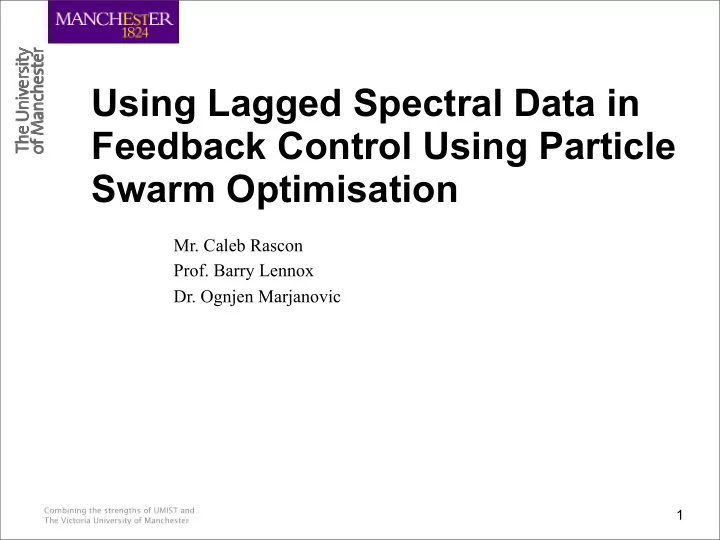

Using Lagged Spectral Data in Feedback Control Using Particle Swarm Optimisation Mr. Caleb Rascon Prof. Barry Lennox Dr. Ognjen Marjanovic Combining the strengths of UMIST and 1 The Victoria University of Manchester
Using Spectral Data in Monitoring • Pharmaceutical Industry – Crystallisation of active ingredients (Yu et. al., 2003) – Confirm sample temperature – Identify material concentrations • Viable as observed variables in feedback control – Or are they? Combining the strengths of UMIST and 2 The Victoria University of Manchester
Difficulties of Using Spectral Measurements • Known for inconsistency due to: – Instrument de-calibration – External and/or sample temperature – Presence of undesired material • Results in frequency displacement (aka, shift, lag) • Disastrous if using reference spectra for analysis Combining the strengths of UMIST and 3 The Victoria University of Manchester
Classical Least Square Regression C = DS ( S T S ) − 1 • D: a spectral measurement • S: set of reference spectra • C: set of concentrations • S and C need to be aligned Combining the strengths of UMIST and 4 The Victoria University of Manchester
Example: Components 0.18 0.16 0.16 0.14 0.14 0.12 0.12 0.1 0.1 0.08 0.08 0.06 0.06 0.04 0.04 0.02 0.02 0 0 0 50 100 150 0 50 100 150 0.2 0.16 0.18 0.14 0.16 0.12 0.14 0.1 0.12 0.08 0.1 0.08 0.06 0.06 0.04 0.04 0.02 0.02 0 0 0 50 100 150 0 50 100 150 Combining the strengths of UMIST and 5 The Victoria University of Manchester
Plant 0.18 0.16 Random 0.14 0.12 Component 1 Spectrum 0.1 Lag 0.08 0.06 0.04 [0,20] 0.02 0 0 50 100 150 0.16 Random 0.14 System 0.12 0.1 Component 2 Spectrum Lag 0.08 0.06 0.04 [0,20] 0.02 0 0 50 100 150 0.16 Random 0.14 0.12 0.1 Component 3 Spectrum Lag 0.08 0.06 0.04 [0,20] 0.02 0 0 50 100 150 0.2 0.18 Random Benchmark 0.16 0.14 0.12 Component 4 Spectrum Lag 0.1 (Components 0.08 0.06 0.04 [0,20] White Spectra) 0.02 0 0 50 100 150 Noise (70 SNR) Controller Desired Component 1 s + 1 1 Concentration Component 1 Σ Π (0.5) Concentration s + 0 . 001 s + 1 Automatic Spectral Desired Analysis Component 2 2 s + 1 1 Simulated Σ Component 2 Concentration Σ Π Sampled Spectra Concentration (PSO or s + 0 . 001 2 s + 1 (0.6) Least Squares) Desired s + 2 1 Component 3 Component 3 Σ Π Concentration Concentration s + 0 . 001 s + 2 (0.7) 2 s + 2 1 Desired Component 4 Σ Π Component 4 Concentration s + 0 . 001 2 s + 2 Concentration (0.8) Estimated Component 4 Concentration Estimated Component 3 Concentration Estimated Component 2 Concentration Estimated Component 1 Concentration Combining the strengths of UMIST and 6 The Victoria University of Manchester
Response using CLSR wo. Applying Lag 0.9 0.8 0.7 0.6 0.5 0.4 0.3 0.2 0.1 0 0 2 4 6 8 10 12 14 16 18 20 Combining the strengths of UMIST and 7 The Victoria University of Manchester
Response using CLSR Applying Lag 1 0.8 0.6 0.4 0.2 0 0 2 4 6 8 10 12 14 16 18 20 Combining the strengths of UMIST and 8 The Victoria University of Manchester
Approach as a Search Problem • Find combination of reference spectra that best fits sample • For each reference spectrum, look for: – Magnitudes → concentrations – Shift suffered – [Others can be added…] • Use Euclidian distance to grade the combination Combining the strengths of UMIST and 9 The Victoria University of Manchester
Particle Swarm Optimisation • Created by Kennedy in 1995 • Simulates a flock of birds ‘flying’ in the solution space • Proven to do as well or better than Genetic Algorithms (Kennedy et. al., 1995) • Easier to implement and visualise • Can incorporate the concept of inertia to speed up search Combining the strengths of UMIST and 10 The Victoria University of Manchester
Response using PSO Applying Lag 0.9 0.8 0.7 0.6 0.5 0.4 0.3 0.2 0.1 0 0 2 4 6 8 10 12 14 16 18 20 Combining the strengths of UMIST and 11 The Victoria University of Manchester
Comparison Mean Square Error of responses using CLSR and PSO Component 1 2 3 4 MSE w. CLSR 0.9639 1.0171 0.6966 1.6604 MSE w. PSO 0.0339 0.0319 0.0375 0.0373 The baseline of comparison is the response obtained when no lag was applied. Combining the strengths of UMIST and 12 The Victoria University of Manchester
Conclusions & Future Work • Classical spectral analysis methods are frail towards lag • As a search problem, lag can be factored in – Other disturbances too • Useful in monitoring: – Inform the need for sensor calibration – Alternative temperature measurements • Search per sample: ~ 6 min – Future work: shortening time of completion Combining the strengths of UMIST and 13 The Victoria University of Manchester
Recommend
More recommend